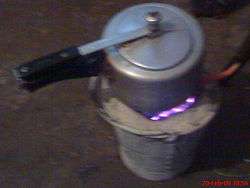Sigri (stove)
A Sigri is a stove used for cooking, especially in North India. The fuel used is usually coal, dried cow dung and wood, and is therefore useful for those who cannot afford liquefied petroleum gas stoves. Sigris are also used during winters for warmth.

Creation
A traditional sigri is made from a steel bucket by first cutting a small hole in the side wall (used later when lighting the stove). Several iron rods are then pushed through the walls about 3 inches below the top across the walls and the interior is covered with approximately an inch of mud paste which acts as an insulator.
Lighting
Lighting a Sigri is requires a substantial amount of effort. First coal, cow dung or wood pieces are loaded from the upper opening. A piece of cow dung (perhaps soaked in kerosene) is then lit and inserted through the hole in the side below the iron rods. The Sigri is then left in the open air until it stops emitting smoke - once up to temperature, it will produce a smokeless heat.
The use of Sigris is now confined to villages and small towns because of the large amount of time it takes to light and the large amount of smoke initially produced. Sigris are a good method for cooking dishes which require an even supply of heat or to impart a smoky flavour.